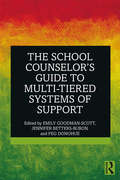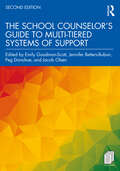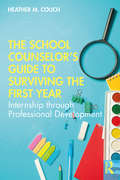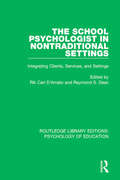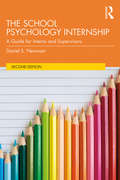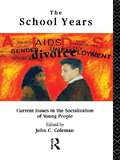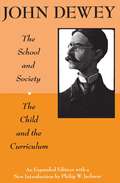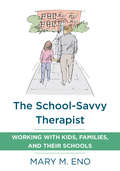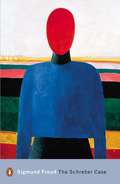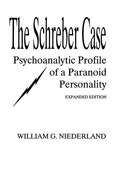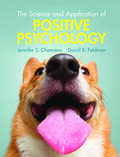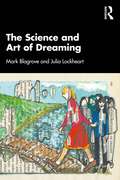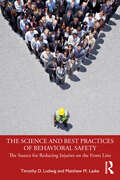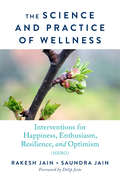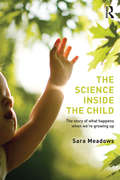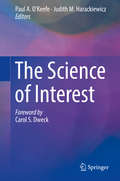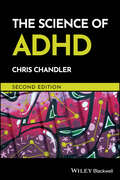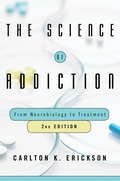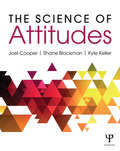- Table View
- List View
The School Counselor’s Guide to Multi-Tiered Systems of Support
by Emily Goodman-Scott Jennifer Betters-Bubon Peg DonohueThe School Counselor’s Guide to Multi-Tiered Systems of Support is the first book to provide school counseling practitioners, students, and faculty with information and resources regarding the alignment and implementation of Comprehensive School Counseling Programs (CSCPs) such as the ASCA National Model and Multi-Tiered Systems of Support (MTSS). This innovative text provides a strong theoretical and research base, as well as practical examples from the field, case studies, and relevant hands-on resources and tools to assist school counselors in comprehending, facilitating, and strengthening the implementation of CSCPs, particularly through MTSS alignment. Furthermore, chapters include pertinent information from the CACREP standards and the ASCA National Model. This book is an essential resource for pre-service and practicing school counselors, as well as their leaders, supervisors, and faculty looking to better understand and utilize the overlap between CSCPs and MTSS, to strengthen school counseling programs to better serve students, schools, and communities.
The School Counselor’s Guide to Multi-Tiered Systems of Support
by Emily Goodman-Scott Jennifer Betters-Bubon Peg Donohue Jacob OlsenThe revision of this innovative book provides school counseling students, practitioners, leaders, supervisors, and faculty with information and resources regarding the alignment and implementation of school counseling, specifically comprehensive school counseling programs. Complementing and expanding upon the audience’s knowledge and implementation of CSCPs such as the ASCA 2019 National Model, chapters include a strong theoretical and research base as well as related practical examples from the field—including case studies of practicing school counselors, and relevant, hands-on resources and tools to assist school counselors facilitate MTSS. New topics such as culturally sustaining and antiracist practice are woven into the chapters, in addition to covering the response to the COVID-19 pandemic, mental health crises, and capturing timely and current practices in K-12 education and school counseling. Innovative, unique, and including a plethora of useful tools and resources, this guide to MTSS and school counseling is ideal for graduate students and current school counselors in the field.
The School Counselor’s Guide to Surviving the First Year: Internship through Professional Development
by Heather M. CouchThe School Counselor’s Guide to Surviving the First Year offers a comprehensive look into the first-year school counseling experience. This practical guide includes topics from internship to professional development from an intimate perspective within the context of real-life scenarios. Drawing from personal experiences, journal articles, textbooks, and excerpts by numerous professional school counselors, it fuses what a school counseling trainee learns in their graduate program and the field experience they get into one unique guide. Emphasizing hands-on approaches, this volume offers personal as well as professional steps toward success in the ins and outs of counseling. This book is a valuable toolkit for the developmental journey of school counselors in-training and beginning school counselors.
The School Psychologist in Nontraditional Settings: Integrating Clients, Services, and Settings (Routledge Library Editions: Psychology of Education)
by Rik Carl D’Amato Raymond S. DeanOriginally published in 1989, school psychology, according to the contributors of this unique volume, is an approach to problem solving, not simply a setting- specific profession. Following Lightner Witmer's original notion, the editors lay a foundation for the field of school psychology in "nontraditional" settings. Such nontraditional practice stems from data showing that school psychologists display skills and abilities that can be applied successfully to a variety of client needs in numerous settings. This special book directly affects both the practicing school psychologist and those in training, as well as professionals and students in clinical child psychology, counseling, and educational psychology.
The School Psychology Internship: A Guide for Interns and Supervisors
by Daniel S. NewmanThe School Psychology Internship is intended to support both doctoral and graduate-level interns and their supervisors (both field and university) in navigating the internship process. Emphasis is placed on the idea that the internship year is a dynamic and formative journey and that interns and supervisors both must be active planners, coordinators, and shapers of the experience. This thoroughly updated 2nd Edition contains an array of helpful resources such as evaluation tools, best practice guidelines, added coverage on doctoral-level training, and sample forms along with all new supplementary materials designed to aid interns in the transition from internship to early career practice.
The School Years: Current Issues In The Socialization Of Young People (Psychology In Progress Ser.)
by John C. ColemanThe School Years provides a challenging and lively collection of essays on key issues affecting young people in the school setting. It is an essential book for all those concerned with adolescence and education. Since the first edition in 1979, major social changes such as unemployment, AIDS, issues of race and gender, and increasing divorce rates have had a direct impact on education and young people. With these dramatice changes in mind, the contributors take an entirely new and up-to-date approach to current controversial issues such as the relationship of home and school, gender roles, morality, delinquency, and peer groups. Contributors include: John Coleman, Trust for the Study of Adolescence; T. Honess, School of Psychology, University of Wales; Peter Kutnick, Department of Education, University of Sussex; Sally Archer, Trenton State College, USA; Philida Salmon, Institute of Education, University of London; Maurice Chazan; David P. Farrington, Institute of Criminology, Cambridge.
The School and Society, and The Child and the Curriculum
by John DeweyAmerica's arch-philosopher of education wrote these two short pieces out of his experience with Chicago's laboratory school which he started in 1896. Dewey's first piece (1915) argues for making the school into a microsociety of the larger one, while in the second (1902) he seeks a curriculum acting as a kind of program for teachers to follow. Teachers can then guide children toward enough self-confidence to be assertive and exercise their capacities. Cited in Books for College Libraries, 3rd ed. Annotation c. Book News, Inc., Portland, OR (booknews.com)
The School-Savvy Therapist: Working With Kids, Families And Their Schools
by Mary EnoWhen it comes to therapy with kids, collaborating with schools and families is essential. Kids encounter problems at school that run the gamut from school violence, to complex systemic problems rooted in poverty or racism, to daily struggles with homework or making friends.Therapists who work with kids typically do not receive training about when and how to contact schools, or about how to work with them collaboratively. The School-Savvy Therapist by Dr. Mary Eno provides a framework, tools, and guidelines for doing just that. Drawing on research, illustrative case examples, and interviews, this practical resource describes what therapists need to know about schools and how they can effectively foster a supportive child–family–school dynamic. From reviewing test results, conducting school observations and attending family–school meetings, to helping parents advocate for their kids and more, this book will help therapists understand the critical role they play in supporting kids who struggle at school.Checklists, questions, and specific guidelines are provided so that both novice and experienced therapists can engage in this work with skill and confidence.
The Schools We Need Now: A Guide to Designing a Mentally Healthy School
by Timothy Dohrer Thomas GolebiewskiPlace mental health at the heart of schooling Our students have always needed our support, but recent events have brought to the forefront the challenges K-12 schools face in supporting their mental health. Now is the time to transform schools into safe and healthy places that enable students not only to learn but thrive. Based on decades of research and proven examples from education professionals and the authors, experts in school leadership and social work, The Schools We Need Now highlights the importance of placing mental health at the heart of schooling and shares a vision for schools that prioritizes student well-being. Inside you’ll discover: Practical ways to improve school climate and mitigate the effects of students’ stress, trauma, depression, and anxiety Preventive activities, school transition and crisis response plans, and community collaboration strategies How to create a comprehensive Mental Health Action Plan that is grounded your school’s culture and climate Examples of schools, classrooms, and organizations that are on the leading edge of creating the schools we need now For every educator who wants to ensure a healthy and equitable school environment for all students, The Schools We Need Now shows you how to create a safe place that protects and supports their academic, social, emotional, and physical growth.
The Schools We Need Now: A Guide to Designing a Mentally Healthy School
by Timothy Dohrer Thomas GolebiewskiPlace mental health at the heart of schooling Our students have always needed our support, but recent events have brought to the forefront the challenges K-12 schools face in supporting their mental health. Now is the time to transform schools into safe and healthy places that enable students not only to learn but thrive. Based on decades of research and proven examples from education professionals and the authors, experts in school leadership and social work, The Schools We Need Now highlights the importance of placing mental health at the heart of schooling and shares a vision for schools that prioritizes student well-being. Inside you’ll discover: Practical ways to improve school climate and mitigate the effects of students’ stress, trauma, depression, and anxiety Preventive activities, school transition and crisis response plans, and community collaboration strategies How to create a comprehensive Mental Health Action Plan that is grounded your school’s culture and climate Examples of schools, classrooms, and organizations that are on the leading edge of creating the schools we need now For every educator who wants to ensure a healthy and equitable school environment for all students, The Schools We Need Now shows you how to create a safe place that protects and supports their academic, social, emotional, and physical growth.
The Schreber Case (Penguin Modern Classics)
by Sigmund FreudThe Schreber Case is distinctive from the other case histories in that it's based on the memoirs of a conjectural patient. Schreber was a judge and doctor of law who lived according to a strict set of principles. His nervous illness first manifested itself as hypochondria and insomnia - which he put down to his excessive workload - but gradually deteriorated into pathological delusion. Believing himself to be dead and rotting, Schreber attempted suicide, and then went on to experience bizarre delusional epsiodes whereby he belived he was being turned into a woman. The course of this extraordinary illness is analysed by Freud in his search for a root cause - could it have been caused by homesexual impulses that Schreber tried to repress?
The Schreber Case: Psychoanalytic Profile of A Paranoid Personality
by William G. NiederlandFirst published in 1984. Routledge is an imprint of Taylor & Francis, an informa company.
The Science Of Acting
by Sam KoganWhat is good acting? How does one create believable characters? How can an actor understand a character if they do not understand themselves? In The Science of Acting, Sam Kogan uses his theories on the relationship between neuroscience, psychology and acting to answer these questions. Practical exercises provide a step-by-step guide to developing an actor's ability, culminating in Ten Steps to Creating a Character. He presents the reader with a groundbreaking understanding of the subconscious and how it can be applied to their acting. The author’s highly original perspective on Stanislavski's teaching gives readers a unique insight into their character’s minds. Sam Kogan studied at the Moscow Institute of Theatre Arts (now the Russian Academy of Theatre Arts) under the tutelage of Professor Maria Knebel. He established The Science of Acting, a complete stand-alone technique. Helen Kogan is the chair and former principal of The Academy of Science of Acting and Directing, has helped to shape her father's words and work for the publication of this book.
The Science and Application of Positive Psychology
by David B. Feldman Jennifer S. CheavensPositive psychology tackles the big questions: What does it mean to live a 'good life'? What helps people to flourish and access their optimal potential? And how can we increase our capacities for joy, meaning, and hope? This engaging textbook emphasizes the science of positive psychology - students don't simply learn about positive psychology in the abstract, but instead are exposed to the fascinating research that supports its conclusions.Bridging theory and practice, this textbook connects up-to-date research with real-world examples and guides students to apply evidence-based practices in their own lives. Its comprehensive coverage includes major new topics, such as spirituality, therapeutic interventions, mindfulness, and positive relationships. Featured pedagogy includes 'Are You Sure about That?' boxes presenting methodological and statistical principles in context, and 'Practice Positive Psychology' activities to extend student learning, while online resources include lecture slides, a test bank, and an instructor manual.
The Science and Art of Dreaming
by Mark Blagrove Julia LockheartThe Science and Art of Dreaming is an innovative text that reviews the neuroscience and psychology of how dreams are produced, how they are recalled and their relationship to waking life events and concerns of the dreamer. Featuring beautiful original artwork based on dream representations, the book delves deeply into what happens when we dream, the works of art we produce when asleep and the relevance of dreaming to science, art and film. The book examines the biological, psychological and social causes of dreaming, and includes recent advances in the study of nightmares and lucid dreaming. It shows how sleep can process memories and that dreams may reflect these processes, but also that dreams can elicit self-disclosure and empathy when they are shared after waking. The playfulness, originality and metaphorical content of dreams also link them to art, and especially to the cultural movement that has most valued dreams – Surrealism. The book details the history of scientific research into dreams, including a re-reading of the two dreams of Freud’s patient, the feminist hero Dora, and also the history of Surrealism and of films that draw on dreams and dream-like processes. Each chapter starts with a dream narrative and accompanying painting of the dream to highlight aspects of each of the chapter themes. This highly engaging book will be relevant to researchers, students and lecturers in the fields of psychology, neuroscience, psychoanalysis, consciousness and social evolution. It will also be of value within the study and practice of visual art, design and film, and will be of interest to the general reader and anyone who holds a personal interest in their own dreams.
The Science and Best Practices of Behavioral Safety: The Source for Reducing Injuries on the Front Line
by Timothy D. Ludwig Matthew M. LaskeThis book presents the scientific principles and real-world best practices of behavioral safety, one of the most mature and impactful applications of behavioral science to reduce injuries in industrial workplaces. The authors review the core principles of behavioral science and their application to modern safety processes. Process components are discussed in detail, including risk analysis and pinpointing, direct observation, performance feedback, reinforcing engagement, trending and functional analysis, behavior change interventions, and program evaluation. Discussions are complemented by industry best-practice case studies from world-class behavioral safety programs accredited by the Cambridge Center for Behavioral Studies (CCBS), which provide compelling evidence of the effectiveness of these behavioral science principles in reducing injury. The Science and Best Practices of Behavioral Safety is essential reading for safety professionals, process safety engineers, and leaders in companies who have implemented, or are considering implementing, behavioral safety; or as an aid to learning more about the scientific background behind effective and practical safety practices. Researchers, expert consultants, and students who are already familiar with the practice will also find the book a valuable source to further develop their expertise.
The Science and Fiction of Autism
by Laura SchreibmanAutism is a complex and incurable constellation of bizarre behaviors, impaired cognition, limited language, and most distressingly, a lack of responsiveness to other people, and it has been the center of impassioned debates for decades. What is it? What causes it? How can it be treated? In The Science and Fiction of Autism, one of the country's leading experts in behavioral treatments approaches autism through the context of its controversies, showing where extraordinary and unfounded claims have falsely raised hopes, stirred fears, and ruined lives. Arguing that autism is an entirely biological disorder, however complex its neurological origins, Laura Schreibman lays waste to the beliefs that it is caused by "refrigerator mothers" or the MMR vaccine, as well as to the simplistic claims that it can be cured by a variety of unsubstantiated treatments. Drawing from her own long clinical experience with autistic children and their parents, Schreibman arms her readers--students, educators, psychologists, and parents alike--with information and arguments to deal with the onslaught of good, bad, deficient, and irrelevant ideas about autism.
The Science and Practice of Lithium Therapy
by Frank Bellivier Gin S. Malhi Marc MassonThis book provides a clear and comprehensive guide to the clinical prescription of lithium that draws upon evidence-based knowledge of its mechanisms of action. The book is divided into two parts, on the science of lithium and the practice of lithium therapy. The former covers aspects such as the properties of the lithium ion, pharmacokinetics and pharmacodynamics, impact on neurotransmission, and gene expression modulation. The section on practice includes discussion of variability in response to lithium, use of lithium in the treatment of bipolar disorders, its value in suicide prevention, administration during pregnancy and in the pediatric age group, and side effects. Lithium is arguably the only true mood stabilizer, and its multifaceted effects across many clinical domains have given rise to a resurgence of interest in recent years, fuelled by both researchers and clinicians. Nevertheless, its use remains constrained by exaggerated concerns about potential side-effects. In reality, lithium is a simple molecule that is relatively straightforward to administer and monitor and has potentially profound benefits at a fraction of the cost of contemporary agents. This book dispels the many myths and concerns that surround its use and will be of interest for clinicians and researchers worldwide, and those that are recipients of lithium therapy.
The Science and Practice of Wellness (HERO): Interventions For Happiness, Enthusiasm, Resilience, And Optimism (hero)
by Rakesh Jain Saundra JainA dynamic approach to mental health and wellness, ready for any clinician to implement. Wellness is rapidly becoming an issue of great importance in clinical practice. Wellness-centric clinicians look to improve various traits known to be beneficial to patients— traits such as happiness, enthusiasm, resilience, and optimism (referred to as the HERO traits). All of these not only improve global mental wellness, but also offer resilience against stress, depression, and anxiety. Wellness-centric interventions augment both psychopharmacology and traditional psychotherapies, such as CBT. Rakesh and Saundra Jain start with an in- depth review of the scientific literature and a practical introduction on applying wellness interventions in various clinical settings. Additionally, they offer advice on such beneficial practices as exercise, mindfulness, optimized nutrition, optimized sleep, enhanced socialization, and positive psychology enhancement. A robust resource section offers access to wellness-centric scales and forms developed by the authors.
The Science inside the Child: The story of what happens when we're growing up
by Sara MeadowsThis engaging book presents some of the ways in which science can describe and explain how and why children develop in the way they do. It looks at children’s individual development within the development of our species, at genes, at the hormone systems that flood our bodies, at the neuroscience of children’s brains, and at patterns of behaviour. It looks, in other words, at the different influences on child development according to the scientific disciplines of evolutionary theory, genetics, epigenetics, endocrinology, neuroscience, epidemiology and psychology. Filled with entertaining anecdotes, Sara Meadows shares the story of what happens when we’re growing up, revealing how science can add depth to our understanding. This book will be an informative and enriching read for all parents, educators and carers, and those interested in how children develop to be emotionally balanced, socially skilled, and enthusiastic seekers after knowledge.
The Science of Interest
by Paul A. O'Keefe Judith M. HarackiewiczThis exceptional volume analyzes the intricate roles interest plays in cognition, motivation and learning, and daily living, with a special focus on its development and maintenance across life domains. Leading experts discuss a spectrum of interest ranging from curiosity to obsession, and trace its functions in goal-setting, decision-making, self-regulation, and performance. New research refines the current knowledge on student interest in educational settings and the social contexts of interest, with insights into why interest levels change during engagement and in the long run. From these findings, contributors address ways to foster and nurture interest in the therapy room and the classroom, for optimum benefits throughout life. Among the topics covered: #65533; Embedding interest within self-regulation. #65533; Knowledge acquisition at the intersection of situational and individual interest. #65533; The role of interest in motivation and engagement. #65533; The two faces of passion. #65533; Creative geniuses, polymaths, child prodigies, and autistic savants. #65533; The promotion and development of interest. A robust guide to a fascinating area of study, The Science of Interest synthesizes the field's current knowledge of interest and indicates future directions. Its chapters contribute depth and rigor to this growing area of research, and will enhance the work of researchers in education, psychologists, social scientists, and public policymakers.
The Science of ADHD
by Chris ChandlerA comprehensive and evidence-based guide to understanding ADHD and its treatment ADHD remains one of the most widely misunderstood neurodevelopmental disorders, with debates surrounding its diagnosis, causes, and treatment continuing to evolve. The Science of ADHD provides a clear, balanced, and up-to-date exploration of this complex condition. With an accessible narrative style, author Chris Chandler expertly navigates the latest research to present an objective look at ADHD's neuroscience, genetics, psychological theories, and treatment approaches. The fully revised second edition reflects the latest advancements in the field, including updated diagnostic criteria and a nuanced discussion of ADHD as a neurodevelopmental disorder. New and expanded chapters address the impact of non-pharmacological treatments, ADHD's association with addiction, ongoing challenges in ADHD research, the broader implications of neurodiversity, and more. Throughout this edition, engaging discussions of genetics, neuroscience, and psychology enable readers to develop a deeper understanding of ADHD and its implications. Empowering readers with the knowledge needed to make informed decisions, The Science of ADHD: Discusses emerging research, treatment innovations, and ongoing questions in ADHD science Balances academic depth with readability, making complex concepts approachable for non-specialists and professionals alike Offers actionable insights for educators, clinicians, and parents to better support individuals with ADHD Covers pharmacological, non-pharmacological, and emerging treatment options, alongside critiques of current approaches Features real-life insights and experiences shared by individuals with ADHD and their family members Includes a glossary and a well-organized layout to help readers navigate scientific terms and concepts effectively Bridging the gap between cutting-edge science and everyday experience, The Science of ADHD, Second Edition, is ideal for undergraduate and postgraduate psychology and neuroscience courses focusing on developmental disorders or psychobiology. It is also a valuable reference for clinicians, educators, and policymakers seeking a research-backed understanding of ADHD to support individuals in diverse settings.
The Science of Addiction: From Neurobiology To Treatment
by Carlton K. EricksonAn updated and expanded edition on the roles that brain function and genetics play in addiction. Over the past 10 years, neurobiologic and genetic research has provided an increased understanding of what causes drug addiction in the brain’s reward pathway. Knowing this leads to a better understanding of how it may be treated and even reversed in those who successfully overcome the disease. This is especially true with addiction’s possible precursors of mild to moderate substance use disorders. These latter disorders can usually be treated more easily by less intensive models of “treatment” that do not require actual brain chemistry re-regulation over time. In this new edition, there are updated scientific references to support addiction as a medical brain disease, using the prevailing neurobiology, genetics, and psychological scientific literature. We now have more psychosocial and medicinal methods for reversing abnormal brain chemistry during drug addiction. There are also more effective intervention, counseling, and motivating methods (SBIRT, motivational interviewing) for overcoming resistance to treatment and resistance to change than were able to be discussed when the first edition was published over a decade ago. Here, readers will find a fully-updated glossary of terms, additional abbreviations, and updated appendices. These will aid in clarifying the somewhat lengthy and science-based upgrades in our knowledge of neuroscience and genetics research that are so critical in understanding why addiction is such a serious and tough-to-treat disease. Utilizing the same easy-to-read language that was a hallmark of the earlier edition, Erickson keeps the science understandable yet comprehensive—appropriate for health professionals as well as lay readers who need and want this critical information.
The Science of Addiction: From Neurobiology to Treatment
by Carlton K. EricksonA comprehensive overview of the neurobiology behind addictions. Neuroscience is clarifying the causes of compulsive alcohol and drug use--while also shedding light on what addiction is, what it is not, and how it can best be treated--in exciting and innovative ways. Current neurobiological research complements and enhances the approaches to addiction traditionally taken in social work and psychology. However, this important research is generally not presented in a forthright, jargon-free way that clearly illustrates its relevance to addiction professionals. The Science of Addiction presents a comprehensive overview of the roles that brain function and genetics play in addiction. It explains in an easy-to-understand way changes in the terminology and characterization of addiction that are emerging based upon new neurobiological research. The author goes on to describe the neuroanatomy and function of brain reward sites, and the genetics of alcohol and other drug dependence. Chapters on the basic pharmacology of stimulants and depressants, alcohol, and other drugs illustrate the specific and unique ways in which the brain and the central nervous system interact with, and are affected by, each of these substances Erickson discusses current and emerging treatments for chemical dependence, and how neuroscience helps us understand the way they work. The intent is to encourage an understanding of the body-mind connection. The busy clinical practitioner will find the chapter on how to read and interpret new research findings on the neurobiological basis of addiction useful and illuminating. This book will help the almost 21.6 million Americans, and millions more worldwide, who abuse or are dependent on drugs by teaching their caregivers (or them) about the latest addiction science research. It is also intended to help addiction professionals understand the foundations and applications of neuroscience, so that they will be able to better empathize with their patients and apply the science to principles of treatment.
The Science of Attitudes
by Joel Cooper Kyle Keller Shane BlackmanThe Science of Attitudes is the first book to integrate classic and modern research in the field of attitudes at a scholarly level. Designed primarily for advanced undergraduates and graduate students, the presentation of research will also be useful for current scholars in all disciplines who are interested in how attitudes are formed and changed. The treatment of attitudes is both thorough and unique, taking a historical approach while simultaneously highlighting contemporary views and controversies. The book traces attitudes research from the inception of scientific study following World War II to the issues and methods of research that are prominent features of today's research. Researchers in the field of attitudes will be particularly interested in classic and modern research on the organization, structure, strength and function of attitudes. Researchers in the field of persuasion will be particularly interested in work on attitude change focusing on propositional and associative learning, metacognition and dynamic theories of dissonance, balance and reactance. The book is designed to present the integration of the properties of the attitude with the dynamic considerations of attitude change. The Science of Attitudes is also the first book on attitudes to devote entire chapters to work on implicit measurements, resistance to persuasion, and social neuroscience.
